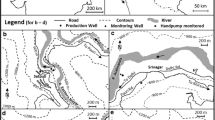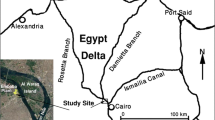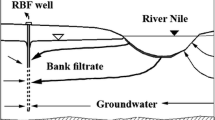Abstract
Ideal locations for bank filtration wells were identified by assessing the efficiency of river bank filtration around a check dam in a non-perennial river located in southern India. The methodology of this study includes water sampling and water level measurements from existing wells, analysis of geochemical and biological parameters, pumping tests and borehole drilling. The conservative chloride and water level measurements indicate that production wells can be positioned up to 300 m from the check dam along the groundwater flow direction. It is recommended that if wells are not receiving 50% surface water contribution, then the production wells must be chosen within 110 m. In addition, the effectiveness of a river bank in improving water quality is evaluated by examining its hydraulic conductivity of 20 to 50 m/day (estimated using borehole data and pumping tests) and travel time and analysed water quality parameters. A significant reduction in microbiological load from surface water is evident even with a short travel time of 46 days. Substantial reduction in turbidity and improved geochemical characteristics were observed in wells located within the production zones which are supported by the Schoeller plot. The above results reveal that for the non-perennial river, in order to achieve maximum benefit through bank filtration, the same well cannot be used as a production well. Based on the water level in the check dam, the direction of groundwater flow and the percentage contribution of the river, it is necessary to shift the production well.











Similar content being viewed by others
Availability of data and materials
This work does not have any data and materials to share with the journal.
References
Anand, C., Akolkar, P., & Chakrabarti, R. (2006). Bacteriological water quality status of river Yamuna in Delhi. Journal of Environmental Biology, 27(1), 97–101.
APHA. (2005). Standard methods for the examination of water and wastewater (21st ed.). Washington D.C.: American Public Health Association (APHA).
ASTM. (2001). Annual Book of ASTM Standards. West Conshohocken, PA 19428–2959.
Bartram, J., & Ballance, R. (1996). Water quality monitoring: a practical guide to the design and implementation of freshwater quality studies and monitoring programmes. CRC Press.
Beyer, W. (1964). Zur bestimmung der wasserdurchlässigkeit von kiesen und sanden aus der kornverteilungskurve. Wasserwirtschaft Wassertechnik, 14(6), 165–168.
BIS. (2012). Indian standard drinking water specification. Second Revision ISO: 10500:2012, Bureau of Indian Standards, Drinking Water Sectional Committee, FAD 25. New Delhi: BIS.
Boving, T., Choudri, B. S., Cady, P., Davis, A., Patil, K., & Reddy, V. (2012). Acceptance of a riverbank filtration system in rural India. Journal of American Water Works Association (Special Issue), 33–41.
Boving, T. B., Patil, K., D’Souza, F., Barker, S. F., McGuinness, S. L., O’Toole, J., … & Leder, K. (2018). Performance of riverbank filtration under hydrogeologic conditions along the upper Krishna River in southern India. Water, 11(1). https://doi.org/10.3390/w11010012
Boving, T. B., Choudri, B. S., Cady, P., Cording, A., Patil, K., & Reddy, V. (2014). Hydraulic and hydrogeochemical characteristics of a riverbank filtration site in rural India. Water Environment Research, 86(7), 636–648.
Bradley, P. M., Barber, L. B., Duris, J. W., Foreman, W. T., Furlong, E. T., Hubbard, L. E., & Kolpin, D. W. (2014). Riverbank filtration potential of pharmaceuticals in a wastewater-impacted stream. Environmental Pollution, 193, 173–180. https://doi.org/10.1016/j.envpol.2014.06.028
Cady, P., Boving, T. B., Choudri, B. S., Cording, A., Patil, K., & Reddy, V. (2013). Attenuation of bacteria at a riverbank filtration site in rural India. Water Environment Research, 85(11), 2164–2174. https://doi.org/10.2175/106143013X13736496909428
Carman, P. C. (1937). Fluid flow through a granular bed. Transactions of the Institution of Chemical Engineers London, 15, 150–156.
Carman, P. C. (1956). Flow of gases through porous media. London, UK: Butterworths.
Cheng, C., & Chen, X. (2007). Evaluation of methods for determination of hydraulic properties in an aquifer-aquitard system hydrologically connected to a river. Hydrogeology Journal, 15(4), 669–678. https://doi.org/10.1007/s10040-006-0135-z
Chow, V. T. (1952). On the determination of transmissibility and storage coefficients from pumping test data. Eos, Transactions American Geophysical Union, 33(3), 397–404.
Dash, R. R., Mehrotra, I., Kumar, P., & Grischek, T. (2008). Lake bank filtration at Nainital, India: water-quality evaluation. Hydrogeology Journal, 16(6), 1089–1099.
Dash, R. R., Prakash, E. V. P. B., Kumar, P., Mehrotra, I., Sandhu, C., & Grischek, T. (2010). River bank filtration in Haridwar, India: removal of turbidity, organics and bacteria. Hydrogeology Journal, 18(4), 973–983.
Davis, S. N., Whittemore, D. O., & Fabryka-Martin, J. (1998). Uses of chloride/bromide ratios in studies of potable water. Ground Water, 36(2), 338–350.
Diem, S., Cirpka, O. A., & Schirmer, M. (2013). Modeling the dynamics of oxygen consumption upon riverbank filtration by a stochastic-convective approach. Journal of Hydrology, 505, 352–363. https://doi.org/10.1016/j.jhydrol.2013.10.015
Dillon, P. J., Miller, M., Fallowfield, H., & Hutson, J. (2002). The potential of riverbank filtration for drinking water supplies in relation to microsystin removal in brackish aquifers. Journal of Hydrology, 266(3–4), 209–221. https://doi.org/10.1016/S0022-1694(02)00166-X
Doussan, C., Poitevin, G., Ledoux, E., & Delay, M. (1997). River bank filtration: Modelling of the changes in water chemistry with emphasis on nitrogen species. Journal of Contaminant Hydrology, 25(1–2), 129–156. https://doi.org/10.1016/S0169-7722(96)00024-1
Essl, L., Starkl, M., Kimothi, P. C., Sandhu, C., & Grischek, T. (2014). Riverbank filtration and managed aquifer recharge as alternative water supply technologies for India: Strengths’weaknesses’opportunities’threats analysis. Water Science and Technology: Water Supply, 14(4), 690–697. https://doi.org/10.2166/ws.2014.026
Fritz, B., Sievers, J., Eichhorn, S., & Pekdeger, A. (2002). Geochemical and hydraulic investigations of river sediments in a bank filtration system. 4th International Symposium on Artificial Recharge of Groundwater (pp. 95–100). Adelaide: AA Balkema.
Ghodeif, K., Grischek, T., Bartak, R., Wahaab, R., & Herlitzius, J. (2016). Potential of river bank filtration (RBF) in Egypt. Environmental Earth Sciences, 75(8), 671.
Ghodeif, K., Paufler, S., Grischek, T., Wahaab, R., Souaya, E., Bakr, M., & Abogabal, A. (2018). Riverbank filtration in Cairo, Egypt—part I: Installation of a new riverbank filtration site and first monitoring results. Environmental Earth Sciences, 77(7), 1–11. https://doi.org/10.1007/s12665-018-7450-2
Grischek, T., Schoenheinz, D., & Ray, C. (2003). Siting and design issues for riverbank filtration schemes. Riverbank filtration: improving source-water quality (pp. 291–302). Dordrecht: Springer. https://doi.org/10.1007/0-306-48154-5_15
Grünheid, S., Amy, G., & Jekel, M. (2005). Removal of bulk dissolved organic carbon (DOC) and trace organic compounds by bank filtration and artificial recharge. Water Research, 39(14), 3219–3228. https://doi.org/10.1016/j.watres.2005.05.030
Hazen, H. A. (1892). The verification of weather forecasts. American Meteorological Journal. A Monthly Review of Meteorology and Allied Branches of Study (1884–1896), 8(9), 392.
Hiscock, K. M., & Grischek, T. (2002). Attenuation of groundwater pollution by bank filtration. Journal of Hydrology, 266(3–4), 139–144. https://doi.org/10.1016/S0022-1694(02)00158-0
Hu, B., Teng, Y., Zhai, Y., Zuo, R., Li, J., & Chen, H. (2016). Riverbank filtration in China: A review and perspective. Journal of Hydrology, 541(August), 914–927. https://doi.org/10.1016/j.jhydrol.2016.08.004
Huntscha, S., Rodriguez Velosa, D. M., Schroth, M. H., & Hollender, J. (2013). Degradation of polar organic micropollutants during riverbank filtration: Complementary results from spatiotemporal sampling and push-pull tests. Environmental Science and Technology, 47(20), 11512–11521. https://doi.org/10.1021/es401802z
Kovačević, S., Radišić, M., Laušević, M., & Dimkić, M. (2017). Occurrence and behavior of selected pharmaceuticals during riverbank filtration in the Republic of Serbia. Environmental Science and Pollution Research, 24(2), 2075–2088. https://doi.org/10.1007/s11356-016-7959-4
Kozeny, J. (1927). Uber kapillare Leitung des Wassers im Boden-Aufstieg, Versickerung und Anwendung auf die Bewasserung, Sitzungsberichte der Akademie der Wissenschaften Wien. Mathematisch Naturwissenschaftliche Abteilung, 136, 271-306.
Kumar, P., Mehrotra, I., Gupta, A., & Kumari, S. (2018). Riverbank filtration: a sustainable process to attenuate contaminants during drinking water production. Journal of Sustainable Development of Energy, Water and Environment Systems, 6(1), 150–161. https://doi.org/10.13044/j.sdewes.d5.0176
Massmann, G., Dünnbier, U., Heberer, T., & Taute, T. (2008). Behaviour and redox sensitivity of pharmaceutical residues during bank filtration–Investigation of residues of phenazone-type analgesics. Chemosphere, 71(8), 1476–1485.
Ministry of Water Resources (MoWR) & Government of India (GOI). (2008). National water mission under national action plan on climate change (pp. 1–471). (December).
Parimalarenganayaki, S., Brindha, K., Sankaran, K., & Elango, L. (2015). Effect of recharge from a check dam and river bank filtration on geochemical and microbial composition of groundwater. Arabian Journal of Geosciences, 8(10), 8069–8076. https://doi.org/10.1007/s12517-015-1825-4
Parimalarenganayaki, S., & Elango, L. (2015). Assessment of effect of recharge from a check dam as a method of managed aquifer recharge by hydrogeological investigations. Environmental Earth Sciences, 73(9), 5349–5361. https://doi.org/10.1007/s12665-014-3790-8
Purandara, B. K. (1999). Groundwater quality studies in the Belgaum district. cs/AR-2999–2000.2000. Available online: http://www.indiawaterportal.org/sites/indiawaterportal.org/files/Groundwater%20Qulaity%20Studies%20in%20Belgaum%20District%20_NIH_1999–2000.pdf (accessed on 12 December 2018)
Ray, C., Soong, T. W., Lian, Y. Q., & Roadcap, G. S. (2002). Effect of flood-induced chemical load on filtrate quality at bank filtration sites. Journal of Hydrology, 266(3–4), 235–258.
Sandhu, C., & Grischek, T. (2012). Riverbank filtration in India–using ecosystem services to safeguard human health. Water Science and Technology: Water Supply, 12(6), 783–790.
Sandhu, C., Grischek, T., Kumar, P., & Ray, C. (2011). Potential for riverbank filtration in India. Clean Technologies and Environmental Policy, 13(2), 295–316.
Schmidt, C. K., Lange, F. T., Brauch, H. J.,Kühn, W. (2003). Experiences with riverbank filtration and infiltration in Germany. DVGW-Water Technology Center (TZW), 1–17. https://doi.org/10.1016/j.oooo.2013.06.024
Schubert, J. (2002). Hydraulic aspects of riverbank filtration—field studies. Journal of Hydrology, 266(3–4), 145–161. https://doi.org/10.1016/S0022-1694(02)00159-2
Slichter, C. S. (1899). Theoretical investigation of the motion of ground waters. The 19th Ann. Rep. US Geophys Survey., 304-319.
Sprenger, C., Lorenzen, G., Hülshoff, I., Grützmacher, G., Ronghang, M., & Pekdeger, A. (2011). Vulnerability of bank filtration systems to climate change. Science of the Total Environment, 409(4), 655–663. https://doi.org/10.1016/j.scitotenv.2010.11.002
Terzaghi, K., Peck, R., & Mesri, G. (1996). Soil mechanics in engineering practice. John Wiley & Sons.
Thakur, A. K., Ojha, C. S. P., Singh, V. P., Gurjar, B. R., & Sandhu, C. (2013). Removal of pathogens by river bank filtration at Haridwar. India. Hydrological Processes, 27(11), 1535–1542. https://doi.org/10.1002/hyp.9301
Todd, D. (1980). Ground water hydrology (2nd ed.). Wiley.
Tyagi, S., Dobhal, R., Kimothi, P. C., Adlakha, L. K., Singh, P., & Uniyal, D. P. (2013). Studies of river water quality using river bank filtration in Uttarakhand, India. Water Quality, Exposure and Health, 5(3), 139–148. https://doi.org/10.1007/s12403-013-0097-z
United Nations World Water Assessment. (2018). Nature-based solutions for water, world water development report.
Vuković, M., & Soro, A. (1992). Hydraulics of water wells: theory and application. Water Resources Publications.
World bank. (2020). Water in agriculture. https://www.worldbank.org/en/topic/water-in-agriculture
World health Organisation (WHO). (2011). Guidelines for drinking-water quality, fourth ed.
Zunker, F. (1932). Zeitschrift fur Pflanzenerwehrung.Duengungund Bodenkunde A25:1.
Funding
The authors thank the Science and Engineering Research Board, Department of Science and Technology, New Delhi, India, for funding this research under the Early Career Research Scheme (Grant number ECR/2016/000840).
Author information
Authors and Affiliations
Contributions
R Anbuchezhian contributed in conception and design of study, acquisition of data, analysis and interpretation of data and drafting the manuscript. S Parimalarenganayaki contributed in revising the manuscript critically for important intellectual content and approval of the version of the manuscript to be published.
Corresponding author
Ethics declarations
Ethical approval
Not applicable.
Consent to participate
Not applicable.
Consent for publication
The manuscript is original. It has not been published previously by any of the author and even not under the consideration in any other journal at the time of submission.
Competing interests
The authors declare no competing interests.
Additional information
Publisher's Note
Springer Nature remains neutral with regard to jurisdictional claims in published maps and institutional affiliations.
Rights and permissions
Springer Nature or its licensor (e.g. a society or other partner) holds exclusive rights to this article under a publishing agreement with the author(s) or other rightsholder(s); author self-archiving of the accepted manuscript version of this article is solely governed by the terms of such publishing agreement and applicable law.
About this article
Cite this article
Rajendiran, A., S, P. Assessing the efficacy of river bank filtration around a check dam in a non-perennial river for rural water supply in southern India. Environ Monit Assess 195, 883 (2023). https://doi.org/10.1007/s10661-023-11485-2
Received:
Accepted:
Published:
DOI: https://doi.org/10.1007/s10661-023-11485-2




